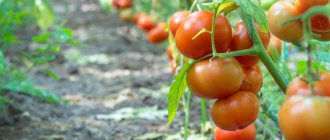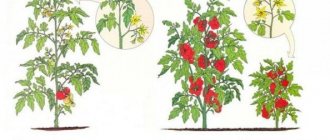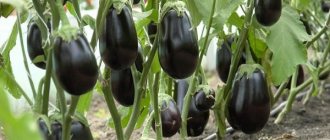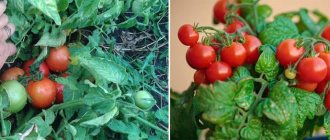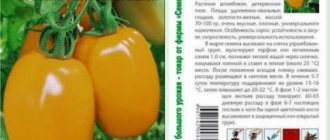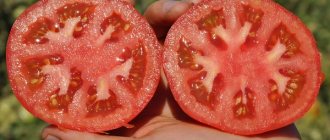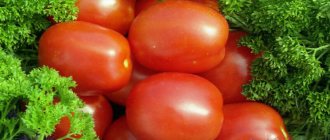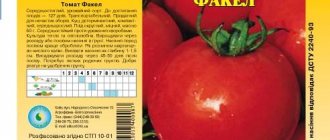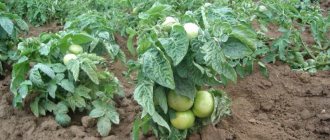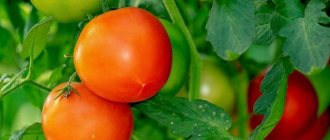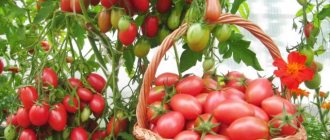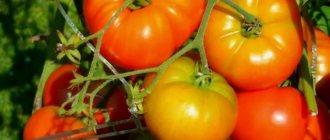Eagle Heart
A tomato with the proud name Eagle Heart occupies the bottom line of our top.
Everyone who grows these giant tomatoes with an elongated tip, shaped like a heart, leaves only positive reviews about it. The weight of the fruit reaches 600-800 g, and sometimes up to 1 kg. One such pink-raspberry fleshy “bug” - and you can feed the whole family with salad! The tomato pulp is sugary, juicy and sweet. The variety is determinate, has a medium ripening period - in a greenhouse with nutritious soil the bushes grow up to 170 cm and require pinching and staking. In open ground they may be slightly lower. But their yield sometimes exceeds 10 kg per bush. For the sake of such impressive results, no effort is spared. Moreover, the tomato shows resistance to most diseases, does not lose its shape during transportation and can be stored for up to 3 months.
The bronze “medal” and 3rd place in the ranking goes to Eagle’s Beak, popular among many tomato growers! The variety is mid-season (110-115 days), semi-determinate - the height of strong bushes reaches 120-150 cm. Proper shaping, tying to a trellis and timely pinching will help them develop harmoniously and bear fruit well. Under ideal conditions and with proper agricultural technology, the yield can be up to 8 kg per bush.
“Eagle beak is the best, I have no competition yet, the leader for today.” Olga Nesmeyanova.
The fruits are large, of unusual shape, with an elongated and curved tip, similar to a beak. On average, they weigh 200-400 g, but some grow up to 800 g. The pulp is dense and juicy, with a sweetish taste.
The variety is resistant to the main nightshade diseases - late blight, fusarium and tobacco mosaic virus. Tomatoes tolerate transportation well due to their thick skin and do not crack during canning.
“I really like Eagle Beak!!!” Nina Belevtseva.
The absolute leader in the popular rating of tomatoes, which received a record number of votes, is the generally recognized and most popular variety, Bull's Heart! A real Senor Tomato in all respects!
The variety is late-ripening - the first fruits (5 pieces in a cluster) ripen 120-130 days after emergence. In open ground, the yield ranges from 3 to 5 kg of tomatoes per bush. In a greenhouse, this figure can increase to 12 kg. Determinate type bush - stems grow up to 1.5 m or more. To achieve record harvests, do not neglect care - timely shaping and tying to the support, preventive treatment against late blight - and the harvest will not keep you waiting!
Review of early varieties
According to breeders, of the early varieties, the most suitable hybrids are the first generation Vyatich, Khlynovsky, Baron F1, as well as the varieties Stolypin, Moskvich. Early fruiting is the ripening of fruits three months after germination. This is very beneficial for such an area with short summers.
Vyatich is classified as a tall crop. The fruits ripen on about the hundredth day. The taste is bright, rich, tomato, sweet and sour. The pulp is dense. The tomatoes are round, small, weighing from 100 to 160 grams. This type rarely gets sick because it is immune to many diseases. Resistant to temperature fluctuations, tolerates cold well. High-yielding variety. Prefers drip irrigation method.
Khlynovsky F1 is also an early ripening type of tomato, a tall hybrid. The bushes must be tied to a support. The fruits are large, heavy, and can weigh up to 300 grams. The skin is dense, glossy, smooth. The pulp is juicy and fleshy. A very productive variety. It is valued for its excellent taste and disease resistance.
Baron is a hybrid with early ripening. The fruits are round and regular in shape. Weight up to 170 grams. Sweet and sour. Has very good immunity. Perfectly stored and transported. Grown for fresh eating and preservation. The juice from them is very healthy and tasty.
Moskvich is a super-early ripening bush, the fruits ripen 85 days after germination. Sweet and sour, not watery, not large. They have a flat-round shape. It is a dwarf plant and does not grow more than 50 centimeters. It tolerates cold well and bears fruit regardless of the climate. Has strong immunity.
Stolypin ripens 80-100 days after germination. It has established itself as a tomato that is not afraid of cold weather, diseases and insects. The variety is low-growing with a limited growing point. Easy care. The fruits are elongated, large, oval in shape. The color is pink or red. Very tasty.
For greenhouse conditions
Manufacturers present seeds separately for greenhouses made of modern plastic materials and lightweight film shelters. It is especially important for a farmer to distinguish between the characteristics of planting material: any mistake reduces the profitability of the enterprise.
For polycarbonate greenhouses
Polycarbonate greenhouses retain heat better than conventional film, so less stress-resistant varieties and hybrids can be placed in them.
Super ed F1
Salad hybrid. Ripens in 115 days. The fruits are red, the flesh is dense, the taste is sweet and sour. The fruits are easy to transport to the place of sale.
Drive F1
It is distinguished by friendly harvest yield. Shows resistance to heat, drought and temperature fluctuations. Not affected by fungal diseases.
See also
How to feed tomato seedlings after picking
Read
Russian Tsar F1
The hybrid is designed for farms and private households. It produces pink-red fruits with excellent taste. The purpose of tomatoes is universal. The harvest is easy to transport to the place of sale.
Kirzhach F1
The bushes are powerful, the stems are strong. The tomatoes grow dense and fleshy. The purpose of using the fruit is universal. The harvest ripens simultaneously on all plants.
DJ F1
The hybrid produces large, transportable fruits. The taste is sweet and sour. The hybrid is unpretentious: it demonstrates resistance to drought and low temperatures.
For film greenhouses and greenhouses
In these shelters the temperature quickly equalizes. Stress-tolerant plants should be placed here.
Tolstoy F1
The hybrid pleases with salad fruits. The bushes are powerful and require shaping and pinching. It is unpretentious in care: it tolerates drought and low temperatures.
Scarlet caravel F1
An excellent new hybrid: breeders introduced it in 2017. The plant is powerful and tall. The fruits are sweet and sour, dense. Tomatoes are stored well under normal conditions. They are easy to transport over long distances.
Intuition F1
The hybrid is distinguished by the uniformity of its fruits: each fruit weighs up to 110 g. The harvest yields uniformly. The fruits have a universal purpose of use.
Bloody Mary
The hybrid was created for cultivation on farms. The fruits have ribbing and juicy pulp. The harvest ripens gradually. Tomatoes are distinguished by their transportability and marketability.
Pink Magic F1
A powerful plant requires pinching and staking. The hybrid is resistant to poor lighting, heat, drought and temperature fluctuations. The fruits are pink-red in color. Marketability is excellent.
Koenigsberg
A mid-season variety of indeterminate (up to 2 m in height) tomatoes, which confidently took 10th place in our amateur rating. The first fruits usually ripen 110-115 days after sowing the seeds. Even beginners can cope with their cultivation. The variety has been tested and hardened in the harsh conditions of Siberia. Therefore, you can safely plant these tomatoes in open ground. Their productivity indicators are impressive - from 4 to 18 kg per 1 sq.m.
“Konigsberg performed well both in the greenhouse and in the OG.” Yuri Kuzminykh.
The oblong fruits ripen in clusters of 6 pieces, they weigh on average 300 g, under favorable conditions the weight can be 2-3 times higher than the standard declared by the manufacturer. Both the skin and the pulp of tomatoes are dense, which makes them easier to transport. Of course, they are healthier to eat fresh, but they are also very tasty in the form of juice, thick paste or sauce. There are varieties of red and yellow color (Golden Konigsberg).
“Konigsberg is an excellent variety, it bears fruit throughout October, from one bush to 2 buckets. In the greenhouse, of course." Lyudmila Petlyuk.
Tomatoes of Siberian selection
These varieties are usually early or early ripening. Such a bush grows to a certain height and stops. The bottom 2-4 inflorescences produce the harvest. Such bushes require formation, perhaps in one stem or two, leaving a stepson under the first inflorescence. But sometimes forming two stems in a greenhouse is impractical, as it leads to crowding of plants, consequently, to a decrease in yield and the occurrence of diseases. Usually in a greenhouse they plant three to four bushes per square area. The more stems are formed, the greater the distance between plants.
They don’t come to fruition, they don’t stop growing. They ripen later than determinate varieties, but the yield is higher due to long fruiting. They are formed exclusively into one stem, which can sometimes reach a height of three meters. They definitely require gartering and constant pinching.
Another species whose tomato seeds of Siberian selection are the most productive. The shape of the fruit is similar to an elongated egg, which could not help but be reflected in the name. The color is red-orange. The weight of tomatoes is 350 grams, the yield is uniformly constant and large. Ripens evenly, the fruits on one cyst can reach 6-8 pieces. The skin is thin.
This is an excellent variety that was able to combine two worthy qualities within itself - it is low, yet large-fruited. The bushes do not reach more than 70-80 cm in height, but with all this, the weight of one tomato can be more than a kilogram. The color is scarlet, the fruits are stored for a long time, which makes it possible to grow them for sale. A very popular variety. Grows in open and closed ground.
Agro (Moscow region) developed “De Barao” - one of the most reliable and well-known varieties of tomatoes for indoor soil. The growing season is 120 days. Tomatoes are indeterminate; powerful shoots can reach two meters in height. Fruiting in the middle zone begins at the end of July and lasts until autumn. It is considered the most productive variety of tomatoes for greenhouses.
The agricultural company “SeDeK” (Moscow region) sells “Golden Fish” - a medium-ripening variety, the first fruits of an elegant yellow color ripen on the 110th day. Plants are of indeterminate type, reaching 1.8-2 m. Tomatoes have an elongated shape with a “spout” at the end. Average weight 110 g. The pulp is dense, sweet, fleshy.
Those who want to explore new varieties should pay attention to the so-called standard tomatoes: this is a determinate variety, very convenient for those. who doesn't have time to care for plants
They have a very strong stem, so they don’t need to be tied up; in addition, their height is only 50-70 cm. This is an almost ideal solution for a small greenhouse, and they can be successfully combined in the same room with indeterminate varieties.
Standard varieties, such as Gavrish, Poisk, Russian Ogorod and others, are considered hybrid; they were obtained by crossing several existing varieties. This is a good option for a beginner, and next year you can choose varieties that are more demanding and difficult to care for. Standard tomatoes will taste very pleasant; they can be grown in any region.
Mid-ripening tomatoes
There are also mid-season tomatoes. These are Flamingo, Merchant, Viscount, Entertainer and Energo F1. Mid-season tomatoes are usually called tomatoes that ripen three and a half months after germination.
Flamingo - usually bears fruit on the 120th day. The fruits are large and round. Excellent storage. Has good health. Suitable for greenhouses and open ground.
Viscount does not require special care. This is a colorful, bright variety with very tasty fruits. They are large, crimson, fleshy. They store very well and give an excellent harvest. Resistant to temperature changes and diseases.
Merchant is a hybrid with large fruits. Red, fleshy, large tomatoes store well. They are grown for salads and canning. Grows well in open ground, not afraid of cold and disease. Unpretentious, but loves fertile soil.
Energo is a tall hybrid. It has established itself as an unpretentious variety developed for all regions of Russia. Productivity is high. Not afraid of cold weather and diseases. The fruits are round, red, and have excellent taste. Good in pickles.
My rural estate The path from a homeless person to the owner of a rural estate.
Tomato seeds for the Kirov region
Author: valera fedorov | Category: Vegetables, Vegetable garden, Tomatoes | 02/23/2012
Tomato seeds for open ground.
I grew tomatoes outdoors for several years. I selected low-growing and non-grafting varieties to make it easier to care for. Here are the varieties of tomatoes that grew and fruited successfully in the conditions of the Kirov region:
| Variety | Selection | Maturation period (days) | Fruit weight (g) | Height (cm) |
| Stolypin | Moscow, Aelita | 95-105 | 90-120 | |
| Betta | Moscow, Gavrish | 80-85 | 50-60 | 40-50 |
| Moskvich | Moscow | 95-107 | 40-60 | 30-45 |
| Unfollowable | Moscow | 50-80 | ||
| Pepper low |
Features of varieties:
"Stolypin" - early ripening, cold-resistant, for canning.
“Nepasynkuyuschiysya” is an ultra-early ripening salad variety.
"Betta" is an ultra-early ripening salad variety. Does not stick and does not require garter.
This year there was an opportunity to purchase a greenhouse made of cellular polycarbonate.
Tomato seeds for greenhouses
| Variety | Selection | Maturation period (days) | Fruit weight (g) | Height (cm) |
| Cherry yellow | Moscow, Gavrish | 95-100 | 50-60 | |
| Verlioka plus | Moscow, Gavrish | 101-105 | 120-140 | 100-150 |
| Pink | Moscow, Gavrish | 90-95 | 120-125 | 150 |
| Truffle yellow | Novosibirsk | 90-150 | 90-170 |
I decided to try the “Family” variety of Kirov selection for greenhouses and open ground. I bought it at the Vyatka Seeds store.
The variety is early, the fruits are large, up to 200. The hybrid is resistant to many diseases and is adapted to the conditions of the northern regions. I'll write about the results.
Tomato varieties for greenhouses of Kirov selection.
Here's what we managed to find out about tomato seeds for greenhouses zoned for the Kirov region from.
All hybrids of this company are divided into four groups.
The first group includes varieties of early ripening hybrids: Baron, Khlynovsky, Semeinny (large-fruited) and Natus, Energo, Gunin (medium-fruited). These varieties are used for salad purposes and are also suitable for pickling and pickling.
The second group includes mid-season hybrids Flamingo (large-fruited) and Viscount (medium-fruited). These tomatoes can be stored for some time.
The third group is Merchant (large-fruited), Adonis (medium-fruited). These tomatoes store well for a long time.
Tall tomatoes are classified in the fourth group: Palladin, Vyatich, Russo, Siver.
Tomatoes of the second and third groups are resistant to nematodes.
Here is a table with some characteristics of tomato seeds for greenhouses, adapted to the northern regions.
| Variety | Selection | Maturation period (days) | Fruit weight (g) | Height (cm) |
| Vyatich | Kirov | early | 130-150 | |
| Baron | Kirov | early | 180-210 | |
| Energy | Kirov | early | 120-140 | |
| Khlynovsky | Kirov | ultra-early ripening | 190-220 | |
| Viscount | Kirov | mid-early | 130-160 | |
| Craftsman | Kirov | 95 | 15-20 | |
| Natus | Kirov | early | 120-150 | |
| Gunin | Kirov | 120 |
The table is, of course, incomplete. I hope that as I become more familiar with these and other varieties, the table will be filled in.
Abakan pink
On the 9th line - a variety of medium-late ripening (110-120 days from germination), determinate type (height - 70-80 cm). In a greenhouse it can grow up to 140-150 cm. The bush needs to be formed into 1-2 stems and tied up. It will ripen pink, heart-shaped fruits (weighing up to 300 g) with tasty, dense pulp. If cared for correctly, you can harvest tomatoes weighing up to 800g, rivaling in size the popular Ox's Heart.
There are many positive reviews about growing this tomato; no one criticizes it. It can be grown in Siberia, and to protect the bushes from returning spring or late autumn frosts, a light film cover will be enough. This representative of the nightshade family rarely gets sick; you will only have to ward off Colorado potato beetles from immature seedlings. In a word, it won’t cause you much trouble, and will delight you with tomatoes – both in salads in the summer and in preparations for the winter.
“I recommend Abakan pink. Unpretentious and very tasty." Lydia Domnikova-Kazakova.
What to choose for open ground
For many summer residents, the size of the vegetable grown matters. They have a good appearance for trading at the market, they can be worn out in front of a neighbor or simply served on the table as a decoration. Their taste properties are usually a little inferior to small fruits, but growing a couple of bushes of such vegetables will not hurt every summer resident. We present to your attention larger-fruited varieties of tomatoes for open ground and their detailed descriptions.
#video_insert_place
Planting should be preceded by spring filling of the ridge with fertilizers. It is better to apply all-inclusive special fertilizers (in stores there is a large selection of such fertilizers, for example, with the inscriptions “for tomato, pepper, eggplant”). But it is possible to get by with azophoska, just be sure to add microelements to it, also potassium and magnesium sulfate. For 1 sq.
m of ridge will need 40 g of all-encompassing fertilizer, 10 g of magnesium sulfate. If the soil is too acidic, add 100 g of chalk or 300 g of wood ash. Ash can be added in any case - excess potassium in the soil will not harm the tomatoes. If in the fall, well-rotted organic matter (peat, humus, compost more than 3 kg per 1 sq. m) and ash were added to the site of the future ridge, then summer fertilizing of ground tomatoes can be eliminated. Limit yourself to watering only.
Impressive results are obtained by feeding ground tomatoes on black covering material (spunbond, geotextile, lutrasil). The covering material not only allows you to retain water in the soil, but also protects the roots of plants from overheating. On the closed surface of the ridge, Asket, Axantha and Cornet tomatoes can be grown without tying them to a peg!
For open ground, you need to choose tomatoes that will not be afraid of cold weather, frost, rain and wind. Unlike greenhouse tomatoes, these tomatoes are very strong and unpretentious, regardless of the ambient temperature they bring a bountiful harvest. This is the latest invention of garden manufacturers. Such tomatoes are mostly low-growing, early-ripening and hybrid.
Among these varieties we can note Ascetic, Axanta, Cornet. They give a very good harvest and are not afraid of cold and heat. They don't have to be tied up. In open ground, it is advisable to cover them with film. Plant seedlings at the end of May. The main thing is not to outgrow it, otherwise there will be a smaller harvest.
The Ascetic tomato has small round fruits weighing one hundred grams. The taste is sweet and sour. They are grown for fresh eating and are also suitable for pickling.
Axantha produces a high yield and has fruits of an unusual yellow-orange color. They make a healthy, unusual juice. It goes very well in salads. Ripens 90 days after seed germination. Tomatoes weigh up to 200 grams. Unpretentious.
Cornet is a very early variety. The fruits are round, slightly ribbed. Small. The plant is very low, about 50 centimeters, and does not need staking. Taste qualities allow it to be used for salads and preparations. The plant is small but produces a good harvest.
In the Kirov region, some farmers plant tomatoes in open ground. They study reviews from colleagues and choose the best varieties and hybrids for themselves.
Low growing tomatoes
Many farmers prefer to cultivate determinate tomatoes. Their yield is lower than that of tall ones, but they also require less care.
Among the tomatoes for growing outside, I liked only five. Although all tomatoes for open ground can be grown in a greenhouse, if there is space. It is simply more efficient to occupy a greenhouse not only in width, but also in height, so it is customary to place low varieties outside, under temporary shelter or without it at all.
The hybrid “Market King III F1” got its name for a reason. I grow it under cover and without, depending on how much space remains in the greenhouse after the main plantings. It is considered early ripening, although I would not say so. I plant it with pleasure, because in any summer - both cloudy and hot - it produces a stable harvest.
Rice. 30. “Market King III F1” produces aligned fruits (in the red basket).
Rice. 31. “Apple tree of Russia” on a bush.
Rice. 32. “Apple Tree of Russia” stores well, including when frozen.
Rice. 33. “Buyan” is a long-known trouble-free variety for open ground.
Rice. 34. “Buyan” is good for pickling.
Rice. 35. I bought “Leningrad Chill” in economical packaging - 200 seeds in one. It lived up to its name, did not freeze during frosts, and grew well both in the greenhouse and outdoors.
Rice. 36. But the yellow-fruited variety “Wonder of the World” turned out to be the most cold-resistant for open ground. It sets an incredible amount of fruit.
From the low ones I also tried “Kremlin F1”, “Peach”, “Orange Sun”, “Dushechka”, “Tiger”, “Sanka”. Despite the hype, these varieties disappointed me.
And finally, dwarfs. These tomatoes are suitable for even the laziest or busiest gardeners. They do not require gartering, watering and, especially, pinching.
Rice. 37. Dwarfs only need to be mulched in mid-June and come to harvest in early August.
Rice. 38. Although, if you sow them at the end of February, you can harvest the first harvest on July 1, as in this photo.
Rice. 39. They bear fruit all summer.
I tried “SamRastet”, “Florida Petit”, “Pygmy”, “Pinocchio”, “Balcony Duet” - I liked them all.
Rice. 40. “Florida Petit” bore fruit even at home.
This year I will have only three new products: the tall “Shuntuk Giant” and the standard “Far North” and “Winter Cherry”. All of them have good reviews on the forum.
Do you have any tomato varieties that you must plant every year? How many are there, and what are they called?
Cio-chio-san
The only disadvantage of this indeterminate (sometimes growing up to 2 m) tomato is the need for support and shaping of the bush. The rest is a set of advantages! It is resistant to unfavorable conditions and can grow even in Siberia and the Far East. It bears fruit well not only in the greenhouse, but also in open ground. It is not afraid of the main nightshade diseases.
“In the greenhouse, I am always pleased with the Chio-chio-san variety from Gavrish. Maria Dolzhikova.
In terms of ripening time, the tomato belongs to the mid-early category - 100-120 days pass from the appearance of the first shoots to the start of fruiting. It won’t let you down with the harvest either - although the tomatoes are small (about 30-40 g on average), they ripen up to 50 pcs. on the brushes! So the yield from a bush with proper care is 4 kg and can reach a record 6 kg. And the taste of this tomato is excellent! And in the blanks it looks very presentable.
“Chio-chio-san - sweet, very productive, tall, with up to 50 smooth, thin-skinned sweet tomatoes in a bunch! Universal for both food and preservation.” Tatyana Vznuzdaeva. Tula region
Low growing tomatoes
Under the conditions of the Kirov region, low-growing varieties performed well in open ground: Betta, Moskvich.
Under the conditions of the Kirov region, low-growing varieties performed well in open ground: Betta, Moskvich.
Betta is a productive, ultra-early ripening, greenhouse variety of Polish selection that can be grown everywhere. From one low bush (50 cm) of standard type, up to 2 kilograms of fruit are harvested.
The fruits are collected in clusters of 5-6 pieces each. The weight of the average fruit is about 50 g. The shape of the fruit is round with noticeable ribbing at the stalk. The pulp contains few seeds, but is quite juicy and tasty. The main advantage of the variety is its early production.
Varieties for greenhouses
Well-known tomato varieties for greenhouses of Kirov producers are Baron, Energo, Flamingo, Adonis, Kupets, Vyatich, Russo, Umelets, Khlynovsky, Natus and others.
Adonis ripens 120 days after germination. High-yielding variety. The tomatoes are small, weighing no more than one hundred grams. The shape is round and regular. The skin is smooth and glossy. Stores well and can be grown for sale. High resistance to fungal diseases.
The craftsman tolerates cold climates well and has strong immunity. The fruits hang in clusters exactly one below the other. They look very nice on a branch. They ripen at the same time. Referred to as cherry, the fruits weigh from 10 to 30 grams. Dark red, bright. They have a sweet taste. Very good for slicing and salads.
Natus is another high-yielding variety. Adapts to any climate. The fruits are red, sweet and sour, flat-round. Ripens at 120 days. The bushes are tall and require staking.
I definitely plant the listed varieties, but there are also some that I just liked, and I periodically grow them in the greenhouse, but I have not become a fan of them. Of the indeterminates, I like the raceme varieties the most. Again, this is primarily because they look beautiful on the bush. There are only three varieties, and each has a special reason to grow it.
“Intuition F1” is a mid-season hybrid, but I would classify it as a late-season hybrid. Not only does it reach harvest ripeness only by mid-August, but biological maturity also comes quite late. Some specimens of these tomatoes ripen even until the end of October. But, on the other hand, this is convenient because as a result, we have our own fresh tomatoes at home for a very long time. That's why I sow it in February.
Rice. 12. Photo from the end of July, but the fruits have not yet begun to ripen.
But “Intuition F1” is very easy. This hybrid is great for freezing for future use. In winter, I make pizza and frittata with them, as they do not defrost like porridge, but retain their meatiness well when cut.
Rice. 13. The fruits are all smooth and beautiful.
Rice. 14. In this form, I send “Intuition F1” to deep freeze.
“Scarlet Candles” is a cluster variety, mid-season. They don’t have a special taste, but what a shape! Looks impressive in preparations with cucumbers. However, this is why I grow them. It’s nice to admire such a jar later in the winter.
Rice. 15. The length of “Scarlet Candles” is almost like pickling cucumbers.
Rice. 16. “Scarlet candles” look neat, they all have a characteristic “spout”.
“De Barao” is quite late-ripening; I sow it earlier than the bulk of tomatoes. I really like it in preparations, it does not crack and is very tasty, both fresh and pickled.
Rice. 17. "De Barao" is resistant to disease. I always plant it on the north side, tying it above the entrance to the greenhouse, because it is very tall, and the upper tier ripens even in the last ten days of August, despite the first cold nights.
Rice. 18. The fruits are beautiful, all as one.
I have tried a great variety of salad varieties, I still want to find the most delicious one. Of the unusually colored tomatoes, I really like the taste of “Malachite Box” and “Black Prince”. Both are tall and require pinching, gartering, and formation into 1-2 stems, but the effort is worth it, the fruits are magnificent. “Black Prince” is dark burgundy when fully ripe.
Rice. 19. “Malachite box” in biological maturity – green.
Rice. 20. All these “Malachite Box” tomatoes are already ripe, although in appearance they seem unripe.
The yellow giants are not inferior in taste, of which the most fleshy and tasty for me are “Yellow Truffle” - of an unusual shape, “Persimmon” - indeed, the pulp is cut like the fruit of the same name, “Golden King” and sweet as a melon, “ Golden Bull." “Golden Heart” and “Altai Yellow” were less impressive. But it should be noted that the shelf life of yellow tomatoes is inferior to red ones.
Rice. 21. Everyone looks the same on the bush. This is Cardinal.
Rice. 22. “Cardinal” is well kept.
Rice. 24. In the foreground is “Mazarin”. It differs only in shape, in taste - like all other red-fruited ones.
Rice. 25. “Altai Reds”, however, can be praised for their friendly maturation.
Separately, I would like to mention the pink-fruited tomatoes “Miracle of the Earth”. If you are lucky with the summer and it is not very hot, then you can get a good harvest from this variety.
Rice. 26. “Miracle of the Earth” are also tall.
But, if there is not very good ventilation in the greenhouse, then this variety will give a characteristic light yellow border, I don’t like it, and I cut it off before use.
Rice. 27. “Miracle of the Earth” - on the right. They are the same size as the Red Giant on the left.
Separately, it should be said about tall cherry tomatoes, for example, “Chio-chio-san”, “Sweet Cherry F1” and others. Yes, many of them are sweet, they look elegant both in the greenhouse and in pickles, but many of them are thrown away and require careful care. No matter how much I refuse to plant them, I still “break down”, I really want to admire the brushes.
Rice. 28. “Red date” is, of course, delicious.
Rice. 29. “Goldilocks” also tastes good if you resist and don’t eat it half-ripe - and it can be eaten even half-ripe.
Yablonka Russia
Tomatoes with such a reverent name could not help but get into the top - they ripen early - from the time the first shoots appear until the moment when the bushes are completely strewn with small round fruits (weighing about 100 g) and really similar to bulk apples, it takes from 118 to 135 days.
Many consider this tomato to be problem-free - it is determinate, standard bushes grow low - up to 100 cm; there is no need to shape them and pin them; They are not capricious and feel great and set fruit both in the greenhouse and in the open ground. One bush can simultaneously ripen up to 100 neat tomatoes suitable for canning - the skin will not burst, there is no need to worry. Not a tomato, but just a sight for sore eyes!
The best varieties of tomatoes
The following varieties are among the favorites also because they do not need to be fanatically cultivated and shaped. And they will always give a harvest: small, large, and a lot, depending on the variety and what I grow them for - for salads, for preparations, or, the smallest and sweetest ones, so that “like seeds, they click.” .
The “Rocket” variety is suitable for both greenhouses and open ground. The fruits are identical in shape and sweet. We love to eat them by the handful. Look good in blanks. The bush requires garter, despite the fact that the package says the opposite. This is because a lot of fruits grow, and the bush bends from the weight. Its height in open ground is about 40 cm, and in a greenhouse it can reach up to 60 cm. This is a mid-season variety; it does not need to be pinched.
What to look for
It is no secret that high yields can only be achieved by following all the rules of agricultural technology and taking good care of the plants.
To choose seeds for 2021, you need to determine, first of all, what ripeness of tomatoes you need, where you will plant them, in an open area or in a greenhouse, as well as weight, shape, color. When choosing tomatoes for cold climates and short summers, you need to pay attention to the fact that they have strong immunity, are resistant to cold weather, and bear fruit in all weather conditions. Tomatoes of the Kirov selection are exactly like this.
Kirov selection tomatoes: the best varieties for greenhouses and open ground
In order to choose tomatoes for planting in the Kirov region for 2018, it is necessary to study which varieties from the Kirov selection for greenhouses and open ground have positive reviews and bear fruit best. In the Kirov region, autumn comes early, already in August it begins to gradually get colder, the nights become longer. Therefore, gardeners there plant tomato varieties for protected soil. They are mainly planted in greenhouses, where they will be more comfortable and warmer.
The most famous. You need to consider the most suitable varieties to plant in this area to decide what to plant next year.
Monomakh's hat
6th step of the conditional “pedestal”. These bright red tomatoes will appeal to lovers of large fruits - they weigh from 400 to 900 g. The pulp has a balanced taste thanks to the harmonious ratio of acids and sugar.
The type of fruiting is mid-early (90-110 days pass from the moment the seedlings are planted). The bushes are indeterminate, formed on a trunk. The plant successfully resists diseases, but prefers warmth to cold, so in the northern regions it is better to plant it in a greenhouse. In protected soil conditions, the yield is impressive and reaches 20 kg per 1 sq.m. In the garden, the indicators are also decent - up to 8 kg per bush.
Reviews
Reviews about Kirov selection tomatoes are always positive. Because these varieties are suitable for any region of Russia, and not just this region. They are unpretentious, have high yields, and are not afraid of cold and temperature fluctuations. In addition, they have strong immunity, which means they get little sick.
Vladimir: planted seeds from a Kirov-based company. They were called Entertainer and Adonis. Excellent varieties. They produced an excellent harvest for two years, incredibly tasty. The foliage was green, clean, and didn’t hurt at all.
Anna: planted the Baron variety. Quite satisfied. Not capricious at all, good harvest. We ate it already in July. Very tasty. They planted it in a greenhouse. We have a site on the north side and in a lowland. But this did not frighten the Baron.
It is important to study different types of seeds before planting and decide on the type that will be planted in the spring. If the choice is made correctly and proper care is provided, then tomatoes will delight the family with a bountiful harvest even in conditions with an unfavorable climate.
It is quite possible to grow tomatoes in a greenhouse in the Kirov region. Indoor soil makes it easier to create a microclimate for tomatoes. Farmers are trying to saturate the market with early vegetable products. But in a harsh climate with a short summer and early autumn, it is only possible to get a tomato harvest in greenhouses. In this case, you should choose varieties and hybrids that produce fruits with a lack of heat and sunlight, that is, zoned ones.
How not to make a mistake when buying tomato seeds ↑
Suppose we have chosen the best varieties of tomatoes for greenhouses and are ready to purchase seeds. How to avoid being deceived and purchase planting material of the expected quality? Intuitively, these rules are known to us, but when our eyes reach the bags with images of dream tomatoes, our hands immediately reach for our wallet. So, you need to firmly understand the following rules.
- Do not take seeds from random sellers in markets. The bags they sell from a trusted manufacturer may contain the cheapest seeds purchased by weight.
- In specialized stores, give preference to a manufacturer that has a good reputation among many gardeners for several years. Often, each seed producer suffers more or less from problematic batches of mis-graded or expired seeds. Therefore, it is worth choosing bags from a company that has not yet been caught doing this.
- Pay attention to the information indicated on the bag. First of all, we are talking about the shelf life, but here you can also glean data that allows you to understand whether the variety is really as good and easy to grow as was previously read in the literature.
Juicy tomato for your table
It's important to understand
Even if you have insured yourself as much as possible against mistakes when choosing seeds, you should not be absolutely sure of a particular variety and rely only on it. Even the consumer of products from a reputable manufacturer is not immune from purchasing low-quality seed material. In order not to be left with nothing but a harvest, it is better to choose several (at least four) varieties for planting. In addition, it would be useful to try new varieties and hybrids every season, drawing your own conclusions about their productivity, because personal experience is the best assistant in making any choice.
teplicnik.ru
Puzata hut
In terms of the number of votes received, it was not far from Monomakh's Cap. The appearance of these tomatoes fully explains the name. Large (300 g), pear-shaped, ribbed, just like squat gnome houses, these tomatoes ripen early - 105-110 days after planting the seedlings. True, they turn red gradually if there is a lot of heat and sun. They are grown in open ground and under film, where they ripen faster. The fruits are fleshy, taste very sweet and juicy.
The bushes are indeterminate, but even in a greenhouse their height rarely exceeds 170 cm. However, it will not be possible to do without shaping. The stems are thin and need staking, as they can lie down under the weight of the fruit. And the yield of these tomatoes, ripening in clusters of 3-5 pieces, is quite decent - 10-11 kg per bush. They are little susceptible to common cultural diseases, but preventive protective measures have never hurt anyone.
“This year I also want a Puzata hut. Last year a friend had them - just a miracle!” Marina Samoilova.
The most popular varieties for the Kirov region
Tomato is a heat-loving and light-loving crop. In addition, the plant has a long growing season. In order to get a guaranteed harvest, it is important to know which varieties and hybrids to plant. It is recommended to pay attention to their characteristics: resistance to shading, growth and formation of ovaries at low average daily temperatures.
Breeders are creating new types of tomatoes specifically for this region. Zoned tomatoes should be planted in the Kirov region first.
- early ripening (up to 100 days from pipping to harvest);
- resistance to fungal diseases;
- stress-resistant: easily tolerates temperature fluctuations;
- bushes with unlimited growth (stretch up to 1.8 m);
- the fruits are red, dense, juicy;
- the taste is sour;
- weight of one tomato up to 170 g;
- excellent transportability.
The advantages of tomatoes are excellent storage and resistance to cracking.
Khlynovsky
This tomato bears fruit 98 days after germination. Characteristic:
- the bush has a massive habit: support is required;
- tomatoes are dense, juicy;
- the taste is sweet, slightly spicy;
- excellent transportability and long storage of fruits;
- vegetable color is red;
- weight up to 300 g.
The tomato is productive: the farmer will receive a guaranteed early harvest.
Stolypin
The variety is resistant to fungi and sudden changes in daytime temperatures. The harvest is ready for sale 80 days after the seeds hatch. Tomatoes are easy to transport over long distances. They store well without refrigeration. The tomatoes are red and dense.
Early ripening tomato. Resistant to fungi and tobacco mosaic virus. The taste is sweet and sour. Baron is intended for cultivation in greenhouses. The fruits are perfectly transported and stored. The tomato is interesting to the consumer: the fruits have a universal purpose.
Energy F1
An excellent tomato for growing in greenhouses and open ground. A plant with a powerful habit: you need to control its size and be sure to plant it with stepson. Tomatoes easily tolerate short-term drought and daily temperature changes. Consumers like to roll flattened, dense tomatoes.
Features of growing tomatoes in the Kirov region
The Kirov region belongs to the zone of risky agriculture, however, in addition to frost-resistant varieties, Kirov summer residents successfully grow exotic varieties of tomatoes of unusual color and shape, bred abroad, early ripening zoned ones, resistant to spring frosts, and ultra-early ripening new items of modern selection. Frequent heavy rains in June and periodic dry winds in July force Vyatka summer residents to grow some garden crops under film cover. To avoid an early invasion of late blight, many do the same with tomatoes. For open ground, the most persistent and unpretentious cultivars are chosen, based on reviews from experienced farmers.
When to start planting
Regardless of the ripening period, greenhouse Vyatichi tomatoes are sown in early March; those intended for cultivation in open ground are sown in the second ten days of the first spring month. Seeds are germinated in special containers filled with turf soil mixed with sand and peat or in peat tablets. At first, the container is covered with glass, this speeds up seed germination.
Despite the climate, due to which the weather in these parts is not always predictable, some gardeners are experimenting with sowing tomatoes directly into the garden. Ultra-early ripening varieties Khlynovsky, Natus, Grand, Dubrava are suitable for this. Sowing is carried out in early May. To do this, choose a sunny place, without drafts. An area of 1 m by 1 m is dug up, filled with a bucket of rotted manure and two glasses of wood ash. Everything is thoroughly mixed and leveled with a fine-tooth rake, grooves are prepared (depth 2–3 cm) and seeds pre-soaked in Epin (Zircon and other growth stimulants) are lowered into them. The mini-beds are loosely covered with glass for the first 5–7 days (depending on the prevailing weather and seasonal temperature conditions), and the soil surface is moistened once a day with a spray bottle. The improvised nursery is blocked with bricks (for example, to the height of two bricks flat), this will be needed to protect the shoots from possible return frosts at night. After a week, the tomatoes begin to hatch. At this time, it is recommended to completely cover the tomato crops at night with plywood or glass (window frame), placing the protection on a brick support. During the day, the shelter is removed. This is done until the third decade of May. Further care for tomatoes is no different from what is required for seedlings grown at home.
This is the basis for a future garden bed; the brick will serve as a support for temporary shelter for germinating seedlings
According to summer residents who practice ground sowing, tomatoes obtained in this way have a strong immunity to diseases, are less afraid of cold weather, and with proper care they yield no less than tomatoes grown through seedlings, only 1.5–2 weeks later.
The seedlings are kept warm (at least +18 C°), but on a window protected from direct sunlight. As the upper layers of the soil dry out, watering is carried out, and liquid fertilizers are applied every 10 days before planting, alternating foliar feeding with root feeding.
After 2 weeks the first shoots appear
As a rule, grown tomatoes are transplanted to a permanent place at the end of May, when warm weather sets in. It is recommended to transplant seedlings in the evening, in dry, windless weather. A handful of rotted manure or peat is added to the prepared holes (about 20-30 cm deep, depending on the size of the young plants) and watered with warm water - 1.5-3 liters per hole. Then the seedlings are lowered into the hole and carefully sprinkled with loose soil, lightly tamping at the base of the shoot.
It’s not scary to bury tomatoes, this way they take root in a new place faster, growing root shoots
After planting, lightly moisten the soil surface at each hole (about 1 liter per root). For the first week, the tomato beds are watered every two days.
Other agricultural techniques necessary for growing tomatoes in the Kirov region
Entering the active phase of the growing season, tomatoes require close attention; it is thanks to daily care that you can get a decent harvest without resorting to chemical treatments. This hard work is very varied and includes the following activities.
- In the Kirov region, tomato beds are watered every 3 days in the hot summer, using 5 liters of water for each bush during active growth, or the tomatoes are watered as the soil dries out (during the rainy season). Towards the end of the season - in the second ten days of August - irrigation is reduced, this will help avoid the invasion of fungal diseases. In greenhouses, it is most convenient to organize drip irrigation; dosed irrigation of tomato plantings makes caring for the vegetable crop easier.
- The aisles are weeded to remove weeds and loosened; the tomato bushes are hilled up a little to ensure the stability of the fruiting stems.
Regular loosening improves air exchange in the upper layers of the soil and prevents harmful insects from accumulating in the nutrient medium of the root base
- During the budding phase, phosphorus-potassium fertilizers containing nitrogen are applied to the roots. And also after 10 days, foliar feeding with boric acid is carried out. During the season, organic liquid fertilizers are applied 2-3 times at the root and the tomatoes are sprayed “leaf by leaf” with preparations that stimulate budding and ovary formation (Zircon, Bud and others).
- Considering that tomatoes in temperate continental climates are susceptible to infection with fungal diseases, they are periodically (from late June to mid-August) sprayed with solutions prepared according to folk recipes. For example, some Vyatka gardeners recommend spraying once every 10 days with an infusion of wood ash (0.5 liters per 3 liters of water) with the addition of 10 drops of iodine and a piece of laundry soap (the size of a walnut). And spraying with herbal infusions (wormwood, yarrow, celandine, garlic tops) also helps to boost the immunity of tomatoes. Heavily infected tomatoes are sprayed with fungicides three to five times every 7 days. For example, tomatoes can be treated with Fitosporin even during fruit formation.
- Vigorous tomatoes are tied to a support.
- The lower drying leaves of tomatoes are periodically torn off, and pinching is carried out as necessary.
Pasynkovani is a procedure especially necessary for vigorous-growing tomatoes that actively grow green mass
A varied assortment of planting material intended for growing tomatoes in Vyatka will not allow any local gardener to be left without their own tomato harvest. The secret of high yields is that there are a lot of cultivars here, adapted to the climatic conditions of the Kirov region, among which there are quite frost-resistant and unpretentious ones. With careful and proper care, according to the Vyatichi people, it is possible to achieve high-quality yield indicators and new varieties, the choice of which is incredibly large today.
A selection of the best varieties of tomatoes for growing in the Kirov region from yagodka.club.
Golden domes
The collected votes allowed these tomatoes to take 4th place in the rating. They have a lot of good reviews, since the variety has almost no flaws, for which it is recognized and loved by many. It exhibits high resistance to major diseases, and timely applied insecticides will repel harmful insects.
Determinate bushes (height from 90 to 150 cm), medium ripening period (100-116 days). You will still have to form it into 2-3 stems and tie it up, so it won’t be possible without any effort on your part. The yield is very good - up to 13 kg per bush with an average weight of tomatoes of 200-400 g, and if the care is good, they will gain all 800 g! Ripe fruits are bright orange, juicy even in appearance. The pulp is fleshy, very tasty, sweet.
“I love golden domes very much - tasty, productive and beautiful. Excellent variety! Lyubov Chernoguz.
De Barao
Having pulled away from its “rivals”, the famous De Barao tomato variety takes an honorable 2nd place in the top varieties. The variety is late-ripening (ripening dates vary from 110 to 130 days from the moment of planting the seedlings), indeterminate (2-3 m), sometimes bushes can grow up to 4 m. The main advantages of the variety are its cold resistance, shade tolerance and productivity.
“The tall De Barao produces stable yields in any weather: in rain, in heat, even in the shade.” Tatiana Trach.
The productivity of De Barao is exceptional - from one bush you can collect from 4 to 10 kg of strong, oblong-shaped fruits weighing about 100 g. It is noteworthy that the plant produces its harvest over a long period of time (up to 3 months). There are varieties with pink, red, yellow and black fruits. Tomatoes store well due to their thick skin and for the same reason are suitable for pickling or pickling.
“The only one who stood in the greenhouse and ripened in October was De Barao. Resistant tin...” Tatiana Gorodetskaya.
The most productive crops
For a farmer, tomato yield is a very important indicator. The profitability of the enterprise directly depends on it.
Cio-chio-san
This tomato grows up to 2 m: staking and pinching is required. The plant is not affected by tobacco mosaic virus and cladosporiosis. The declared yield of plum tomatoes is up to 4 kg/bush.
See also
Description of rare collectible tomato varieties from Valentina Redko, new for 2021
Read
Semko-Sinbad F1
This is a compact hybrid of early ripening. Tomatoes are medium size (80-90 g), dense, red in color. A farmer can get (with proper agricultural technology) up to 10 kg/square meter of greenhouse.
De Barao
Breeders present several variations of the variety:
- with red fruits;
- with yellow;
- with black (green-brown).
The berries are plum-shaped. The fruits are collected in clusters of 8 pieces. The bushes are powerful and indeterminate: they require staking and pinching. Productivity - up to 12 kg/square meter of greenhouse.
Hybrid Ivanhoe F1
A plant with a powerful habit: it requires staking and the formation of 2-3 stems. The fruits grow up to 170 g. It is required to grow 2-3 bushes per 1 square meter of area. The declared yield is up to 12 kg/square meter.
Alhambra
The tomato has an average ripening period (115 days from pipping to the first fruits). The bush is spreading and tall. The harvest is given at the same time. The farmer can get up to 13 kg/square meter of greenhouse. Currently, the creator of the variety has stopped producing hybrid seeds.
